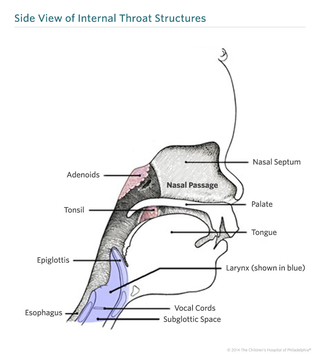What is the throat?
The throat (pharynx and larynx) is a ring-like muscular tube that acts as the passageway for air, food and liquid. It is located behind the nose and mouth and connects the mouth (oral cavity) and nose to the breathing passages (trachea [windpipe] and lungs) and the esophagus (eating tube). The throat also helps in forming speech.

The throat contains the:
- Tonsils and adenoids — made up of lymph tissue. Tonsils are located at the back and sides of the mouth and adenoids are located behind the nose. They both help to fight infections. Removal of tonsils and adenoids, when necessary, will not reduce your child's ability to fight infections since there are many other tissues to perform that function.
- Pharynx — is the muscle-lined space that connects the nose and mouth to the larynx and esophagus (eating tube).
- Larynx — also known as the voice box, the larynx is a cylindrical grouping of cartilages, muscles and soft tissue that contains the vocal cords. The larynx is the upper opening into the windpipe (trachea), the passageway to the lungs.
- Epiglottis — a flap of soft tissue and cartilage located just above the vocal cords. The epiglottis folds down over the vocal cords to help prevent food and irritants from entering the lungs.
- Subglottic space — the space immediately below the vocal cords. It is the narrowest part of the upper airway
Review date: April 2009
Reviewed by